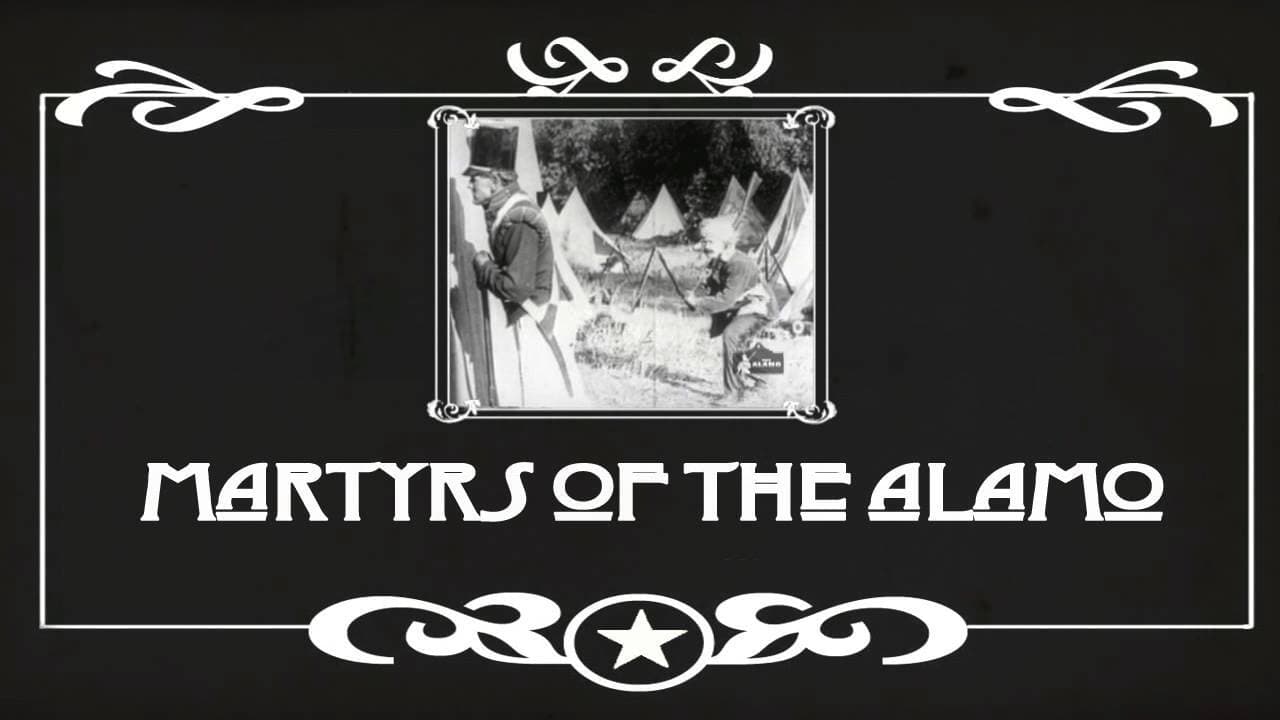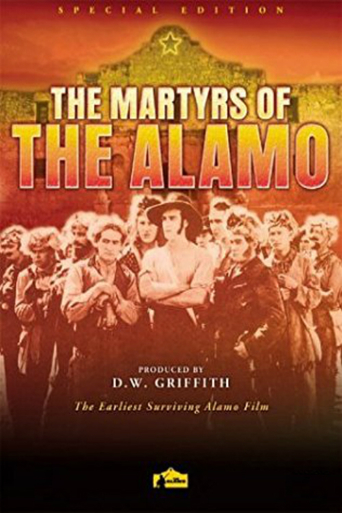

As we know, "The Birth of a Nation" (1915), directed by D.W. Griffith, justifies the institution of slavery and the rise of the Ku Klux Klan during Reconstruction as the need to protect white women from Negro lust. Later that year, Griffith also produced "Martyrs of the Alamo," which reveals that the war in which Texas declared and won its independence from Mexico was brought about by Mexican lust for white women. So many white women were being accosted by the Mexican soldiers, it seems, that the white men finally had to take up arms to protect them. When Santa Anna and his troops come in to put down the rebellion, the Texians took refuge in the Alamo, and we all know what happened next.As an example of how cruel and ruthless the Mexican soldiers are, we see a scene in which a little boy is bayonetted, his body picked up and flung out of the way. And when the battle is over, Santa Anna has anyone that survived the massacre executed, except for good-looking white women, of course. We see an old woman being taken away for execution, while a young, pretty blonde is spared. The intertitle notes that Santa Anna is an inveterate drug fiend known for his shameless orgies. Right after that, we see him grabbing the pretty blonde, but she slaps him and gets away from him. By the way, Santa Anna is played by Walter Long, the same man that played Gus in "The Birth of a Nation," the black man that tried to rape Flora.We have all heard how the Mexican soldiers were caught off guard when Sam Houston attacked at San Jacinto because they were taking their siesta. But in addition to that, according to this movie, Santa Anna, appearing somewhat stoned, is busy having women dance for him, while a Mexican guard watches the show himself instead of watching for such things as an advancing army of Texians. So, Mexican lust not only was the cause of the Texas revolution, it was also the cause of Mexico's defeat as well.
... View MoreWith its subtitle "The Birth of Texas" taking up most of the screen, it's obvious "Martyrs of the Alamo" was made to ride the coattails of D.W. Griffith's "The Birth of a Nation" (1915), which was already an astonishing success. Mr. Griffith is credited as a supervisor, and it looks like his story ideas and suggestions were taken into account. However, Griffith did not personally direct this knock-off. The creativity of Griffith's work with cameraman Billy Bitzer is not evident. Director Christy Cabanne is good at motioning the cast, but the camera positions are relatively staid. Still, as the film progresses, you will see some increasingly good movement of personage forward and backward.Mr. Cabanne would soon find success directing the soon popular Douglas Fairbanks, who appears here in "black-face". As for the story, it's about as historically accurate as you might expect for the time (meaning not very). Like most "war" films, the view is subjective. You wouldn't expect many U.S.-made World War II films to be pro-German, and "Martyrs of the Alamo" is not pro-Mexican. What really hurts is that the fictionalization adds nothing to the characters. Griffith's historical epics made up characters and situations that were much more interesting and entertaining. One line says it all - "An inveterate drug fiend, the Dictator of Mexico (was) also famous for his shameful orgies." ***** Martyrs of the Alamo (11/21/15) Christy Cabanne ~ Sam de Grasse, Allan Sears, Walter Long, Alfred Paget
... View MoreThe historical accuracy of the films of D.W. Griffith is negligible to say the least! His films seem to portray history the way Griffith wished it were instead of how it really was. In Griffith's world, the South was glorious and slavery an honorable institution--and this is pounded home in many of his films. The public ate these movies up and people thereby became ignorant of American history. His most famous film, BIRTH OF A NATION, is an amazing film to watch but as a history lesson, it's pure junk--as are many of his lesser films, such as ABRAHAM LINCOLN. Here with MARTYRS OF THE ALAMO, Griffith once again plays very fast and loose with facts. The main one you may notice when the film began is his retelling of the reasons for the Texas rebellion. While it's true that Antonio López de Santa Anna was a horrible leader (they didn't come much stupider--read up on the Pastry War and how the Mexicans lost Texas at San Jacinto to see what I mean), one of the main reasons for the war was than many Texans wanted slavery--while this was expressly forbidden by Mexican law. So at least some of the reason for this war was less than noble and Griffith, not surprisingly, ignores the evils of slavery--something he did is a much grander fashion with BIRTH OF A NATION. As for the Mexicans in the film, they are pretty indistinguishable from the Black people in BIRTH OF A NATION. In other words, many of them are Americans of European stock who were painted up with dark dye to look "Mexicany" and some behaved like jerks and sexual perpetrators! The Black people in the film were also painted like this, though they didn't really do much of anything other than sit back and watch or in an odd twist, help the Texans! Now if you aren't looking at the film as fact and look at it from a film history point of view, it is an incredible film. For 1915, it is one of the best costume dramas made in America up until this time and Griffith always had a knack for filming spectacular battle sequences. The costumes look much better than you'd see in contemporary films, though I doubt if so many of the Americans wore coonskin caps. The Mexican troops were pretty appropriately dressed and the guns were not repeating rifles like I've actually seen in a couple films set in the 1830s (they weren't invented yet or those few examples that existed were very, very rare and were mostly only test models). The sets weren't bad, though the Alamo in the film looked nothing like the actual building and there were a lot of trees and bushes where there shouldn't have been any.So overall, the film looked great and was highly entertaining for 1915. While not as patently racist as BIRTH OF A NATION (also 1915), the film is a mess historically, as many of the details of the film were wrong--though this is true in some later films as well.By the way, you may recognize the man who played Santa Ana. It's Walter Long who starred in several Laurel and Hardy films and he was a rather prolific actor during the 1930s.I actually found it one YouTube--chopped into pieces and shown in low resolution. Despite these problems, believe it or not, the sound track was excellent and the opening prologue which was recently added was very good--though I have no idea who the guy is who introduces the film. I also just checked and it's also available from NetFlix and if you are a member I suggest you try there first.
... View MoreThey tell a lot of whoppers in here, everything from fictitious people and inciting events that never happened to a secret passage in the fort. There's a lot of propaganda here too (and let's just not get into the number of coonskin hats). There's also plenty to offend modern sensibilities today, as almost every North American stereotype of Mexicans is displayed, as is Douglas Fairbanks...in blackface.That said, this first feature film (a five-reeler) about the Alamo (the very first Alamo film came out four years earlier but has been lost) tells us a lot about how people less than 80 years after the event and less than 70 years after the end of the Mexican-American War remembered it. Bowie, Travis, and Crockett are there, of course, but the viewpoint character is actually Deaf Smith (here called Silent Smith).I didn't recall hearing about Deaf Smith before, but after looking him up on the Net, realize just how important he was in that struggle. The chief reason for his importance -- his marriage to a Latina and the contacts in both American and Mexican circles that enabled him to earn the nickname "The Texas Spy" -- isn't in the film, but at least they acknowledged his presence at the scene and the importance of his role then. The resemblance between his portrait and the actor who plays him, Sam De Grasse (who Fairbanks fans will remember fondly for his portrayal of Prince John in "Robin Hood"), is also remarkable.The camera techniques are excellent, too, and must have been groundbreaking in 1915. There are two challenges here: scenes where large numbers of actors, including soldiers on horseback, must move through small spaces (the streets of San Antonio) without overwhelming the audience, as well as battle scenes where a wide open expanse of land and sky has to be filled up with an attacking Mexican Army. They solved the former by imaginative camera angles of the big picture interlaced with multiple, quickly moving close-ups of various important characters in the street during the crowd scenes. They did the best they could with the latter, including a fish-eye view with wide borders during some of the charges on the Alamo, but they really could have used more actors out there to convey the overwhelming numerical superiority of the Mexican forces. Considering it was 1915, though, what they did was very impressive.I like the way the end, after Santa Anna's men have broken into the fort, is filmed as a series of separate fights that fade into darkness. One should point out, though, that in the real battle, Santa Anna did let all the women and children go.At the very end, they also do something interesting with the flags that reminds me a little of the way a modern movie about the Civil War, "Gods And Generals," opens.I saw the print that is available at the Internet Archive, http://www.archive.org. It's not of the best quality, with some but not all of the title cards at the end of the original reels still in the picture, and also with some break-up at the end. It also has a good sound track that's generally very epic and powerful, but it isn't tied in to what is showing on the screen. Something more in sync with the film's scenes and with a few, lighter human melodies and country refrains reminiscent of the era, probably would enhance the experience.
... View More